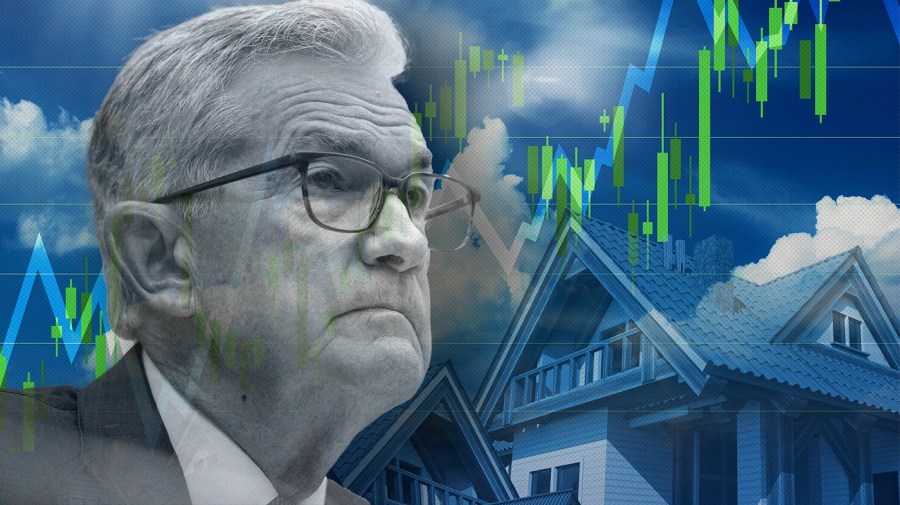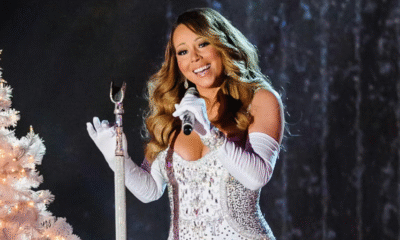Business
Fed’s rate strategy stymied by stubborn housing cost inflation on November 8, 2023 at 11:00 am Business News | The Hill

The Federal Reserve is facing questions about its ability to tame one of the largest drivers of inflation: the cost of housing.
Housing costs, measured as both rental costs within the consumer price index (CPI) and as mortgage rates, are one of the most interest rate-sensitive sectors of the economy, generally getting more expensive as rates go up and cheaper as rates go down.
But with the Fed now expected to keep rates higher for longer, a reprieve in shelter costs, which constitute a major portion of monthly expenditures for U.S. households, could still be a ways away.
Consumers remain hobbled by housing costs
Americans spend about 30 percent of their income on rent, according to research from Moody’s Analytics published over the summer, a record threshold initially reached last year.
Moody’s has described Americans as “rent-burdened,” arguing in April that “rent-to-income levels remain uncomfortably high.” In 2021, 20 million households that pay rent met the 30-percent income threshold and were “cost burdened,” according to the Census Bureau, an increase of about 1 million households since 2019.
“If you look at the consumer price index, the big contributor to high inflation is the shelter, both rents and owner-occupied rents,” Claudia Sahm, founder of Sahm Consulting and a former Federal Reserve economist, told The Hill.
“The increases in shelter costs have absolutely slowed down in the past six to eight months, but they take time to work their way through. … Frankly, we’ve gotten surprised at how long it’s taken and how bumpy it’s been.”
Fed faces pressure to cool down housing market
Inflation has been coming down over the past year as the Fed has been raising rates, falling to an annual rate of 3.7 percent in September from a high of 9.1 percent in June of last year.
But annual housing inflation is still around 7 percent and accounts for the vast majority of all the inflation left in the economy.
The CPI’s shelter index accounted for more than 70 percent of the total increase in all items less food and energy, the Labor Department reported earlier this month.
“The Fed needs to study the housing market at this moment very carefully, because it’s at the point where it really starts to have an effect,” Sahm said. “[Fed Chair Jerome Powell] pointed to the housing market, because it’s clear that activity there is slowing down.”
While one of the fastest Fed tightening cycles on record has driven housing costs higher, an underlying shortage of affordable, multifamily housing has also dogged the housing market.
Realtor.com puts the shortage at between 2.3 and 6.5 million homes.
Can Powell tame property owners?
Tenants-rights activists say that focusing on the financial system or even the physical supply of housing is shortsighted and neglects the fact that landlords and property owners simply have too much power over tenants, allowing them to drive up prices at will.
“Federal housing policy is designed in a way that prioritizes the industry that profits from providing housing, rather than the people who need homes,” argued the Homes Guarantee advocacy group, which wants to see rent control limitations placed on all national housing subsidy programs.
The group also wants to see the Biden administration enact a national tenants bill of rights to protect against profiteering in the housing sector as a matter of public policy.
Powell said Wednesday that effects of housing costs on the economy were becoming “significant.”
“We’re getting reports from housing that the effects of this could be quite significant,” he said, noting that activity in the housing sector has flattened out and remains well below levels of a year ago.
Housing remains in the Fed’s sights
The Fed’s latest anecdotal survey of the U.S. economy is riddled with complaints about the affordability of housing.
“Housing affordability remained extremely low, and rents remained high in the current period. Requests for assistance with housing and utility bills continued to dominate 211 [hotline] requests in New Jersey and Pennsylvania. Roughly one-third of all requests in the two states were related to housing,” the Federal Reserve Bank of Philadelphia reported in the October “Beige Book,” the Fed’s monthly summary of regional economic conditions.
Rental and home ownership affordability as measured in September by the Department of Housing and Urban Development are both near 23-year lows, while month-to-month house prices were near 20-year highs.
“Rising rents and a shortage of affordable housing continued to impact low- and moderate-income households’ ability to secure housing. Moreover, some landlords stopped accepting housing choice vouchers in order to get higher rents in the open market,” the Cleveland Fed observed.
Despite elevated levels, shelter prices have been declining in recent months, with owners’ equivalent rent falling to 7.1 percent in September off a high of 8.1 percent in April.
The shelter component of the CPI also stands at 7.1 percent, off a March peak of 8.2 percent.
But that descent has been touch-and-go and has been a source of surprise for economists.
“It was clear this was coming, but last month forecasters were surprised; it didn’t come down as much as we’d expected. We don’t know exactly how the translation goes between new rents and the CPI,” Sahm said.
“We know the direction of this, but exactly when it happens is not clear, and shelter makes a bigger contribution to the CPI in general, so it’s not like this inflation is just going away.”
Thirty-year fixed-rate mortgages are near their highest levels in 23 years, at 7.86 percent.
“The impact of higher rates continued to be felt across both purchase and refinance markets. Purchase applications decreased to their lowest level since 1995 and refinance applications to the lowest level since January 2023,” Joel Kan, Mortgage Bankers Association vice president, wrote in a note Wednesday.
Economists sound the alarm on bond yields
Soaring bond yields, which are closely correlated with mortgage rates, especially for longer-term maturities, were also a concern for economists watching the outcome of the Fed’s meeting.
“Powell’s focus on persistent conditions, especially regarding the rise in Treasury yields and the near-8% mortgage rate, suggests that the Fed is closely monitoring the broader economic indicators,” Jon Maier, head of investments at financial firm Global X, wrote in an analysis.
Despite the high cost of housing, home ownership rates for moderate earners rose to some of their highest levels ever during the pandemic, boosted by trillions in stimulus sent out by both the Trump and Biden administrations.
In the first quarter, the homeownership rate for Americans earning less than the median family income of $74,580 hit 53.4 percent, a number surpassed in recent decades only during the second and third quarters of 2020, when the government was helicoptering emergency cash onto households during the pandemic, according to Census Bureau data.
Powell stressed Wednesday that Fed bankers had not yet made up their mind about future rate hikes or whether Fed policy was now sufficiently “restrictive.”
“We’re not confident at this time that we’ve reached such a stance. We’re not confident that we haven’t, but we’re not confident that we have,” Powell said.
Business, Administration, News, Policy, Technology, bonds, federal reserve, Federal reserve rate hikes, housing market, Jerome Powell The Federal Reserve is facing questions about its ability to tame one of the largest drivers of inflation: the cost of housing. Housing costs, measured as both rental costs within the consumer price index (CPI) and as mortgage rates, are one of the most interest rate-sensitive sectors of the economy, generally getting more expensive as…
Business
Google Accused Of Favoring White, Asian Staff As It Reaches $28 Million Deal That Excludes Black Workers

Google has tentatively agreed to a $28 million settlement in a California class‑action lawsuit alleging that white and Asian employees were routinely paid more and placed on faster career tracks than colleagues from other racial and ethnic backgrounds.
- A Santa Clara County Superior Court judge has granted preliminary approval, calling the deal “fair” and noting that it could cover more than 6,600 current and former Google workers employed in the state between 2018 and 2024.

How The Discrimination Claims Emerged
The lawsuit was brought by former Google employee Ana Cantu, who identifies as Mexican and racially Indigenous and worked in people operations and cloud departments for about seven years. Cantu alleges that despite strong performance, she remained stuck at the same level while white and Asian colleagues doing similar work received higher pay, higher “levels,” and more frequent promotions.
Cantu’s complaint claims that Latino, Indigenous, Native American, Native Hawaiian, Pacific Islander, and Alaska Native employees were systematically underpaid compared with white and Asian coworkers performing substantially similar roles. The suit also says employees who raised concerns about pay and leveling saw raises and promotions withheld, reinforcing what plaintiffs describe as a two‑tiered system inside the company.
Why Black Employees Were Left Out
Cantu’s legal team ultimately agreed to narrow the class to employees whose race and ethnicity were “most closely aligned” with hers, a condition that cleared the path to the current settlement.

The judge noted that Black employees were explicitly excluded from the settlement class after negotiations, meaning they will not share in the $28 million payout even though they were named in earlier versions of the case. Separate litigation on behalf of Black Google employees alleging racial bias in pay and promotions remains pending, leaving their claims to be resolved in a different forum.
What The Settlement Provides
Of the $28 million total, about $20.4 million is expected to be distributed to eligible class members after legal fees and penalties are deducted. Eligible workers include those in California who self‑identified as Hispanic, Latinx, Indigenous, Native American, American Indian, Native Hawaiian, Pacific Islander, and/or Alaska Native during the covered period.
Beyond cash payments, Google has also agreed to take steps aimed at addressing the alleged disparities, including reviewing pay and leveling practices for racial and ethnic gaps. The settlement still needs final court approval at a hearing scheduled for later this year, and affected employees will have a chance to opt out or object before any money is distributed.
H2: Google’s Response And The Broader Stakes
A Google spokesperson has said the company disputes the allegations but chose to settle in order to move forward, while reiterating its public commitment to fair pay, hiring, and advancement for all employees. The company has emphasized ongoing internal audits and equity initiatives, though plaintiffs argue those efforts did not prevent or correct the disparities outlined in the lawsuit.
For many observers, the exclusion of Black workers from the settlement highlights the legal and strategic complexities of class‑action discrimination cases, especially in large, diverse workplaces. The outcome of the remaining lawsuit brought on behalf of Black employees, alongside this $28 million deal, will help define how one of the world’s most powerful tech companies is held accountable for alleged racial inequities in pay and promotion.
Business
Luana Lopes Lara: How a 29‑Year‑Old Became the Youngest Self‑Made Woman Billionaire

At just 29, Luana Lopes Lara has taken a title that usually belongs to pop stars and consumer‑app founders.
Multiple business outlets now recognize her as the world’s youngest self‑made woman billionaire, after her company Kalshi hit an 11 billion dollar valuation in a new funding round.
That round, a 1 billion dollar Series E led by Paradigm with Sequoia Capital, Andreessen Horowitz, CapitalG and others participating, instantly pushed both co‑founders into the three‑comma club. Estimates place Luana’s personal stake at roughly 12 percent of Kalshi, valuing her net worth at about 1.3 billion dollars—wealth tied directly to equity she helped create rather than inheritance.

Kalshi itself is a big part of why her ascent matters.
Founded in 2019, the New York–based company runs a federally regulated prediction‑market exchange where users trade yes‑or‑no contracts on real‑world events, from inflation reports to elections and sports outcomes.
As of late 2025, the platform has reached around 50 billion dollars in annualized trading volume, a thousand‑fold jump from roughly 300 million the year before, according to figures cited in TechCrunch and other financial press. That hyper‑growth convinced investors that event contracts are more than a niche curiosity, and it is this conviction—expressed in billions of dollars of new capital—that turned Luana’s share of Kalshi into a billion‑dollar fortune almost overnight.
Her path to that point is unusually demanding even by founder standards. Luana grew up in Brazil and trained at the Bolshoi Theater School’s Brazilian campus, where reports say she spent up to 13 hours a day in class and rehearsal, competing for places in a program that accepts fewer than 3 percent of applicants. After a stint dancing professionally in Austria, she pivoted into academics, enrolling at the Massachusetts Institute of Technology to study computer science and mathematics and later completing a master’s in engineering.
During summers she interned at major firms including Bridgewater Associates and Citadel, gaining a front‑row view of how global macro traders constantly bet on future events—but without a simple, regulated way for ordinary people to do the same.

That realization shaped Kalshi’s founding thesis and ultimately her billionaire status. Together with co‑founder Tarek Mansour, whom she met at MIT, Luana spent years persuading lawyers and U.S. regulators that a fully legal event‑trading exchange could exist under commodities law. Reports say more than 60 law firms turned them down before one agreed to help, and the company then spent roughly three years in licensing discussions with the Commodity Futures Trading Commission before gaining approval. The payoff is visible in 2025’s numbers: an 11‑billion‑dollar valuation, a 1‑billion‑dollar fresh capital injection, and a founder’s stake that makes Luana Lopes Lara not just a compelling story but a data point in how fast wealth can now be created at the intersection of finance, regulation, and software.
Business
Harvard Grads Jobless? How AI & Ghost Jobs Broke Hiring

America’s job market is facing an unprecedented crisis—and nowhere is this more painfully obvious than at Harvard, the world’s gold standard for elite education. A stunning 25% of Harvard’s MBA class of 2025 remains unemployed months after graduation, the highest rate recorded in university history. The Ivy League dream has become a harsh wakeup call, and it’s sending shockwaves across the professional landscape.

Jobless at the Top: Why Graduates Can’t Find Work
For decades, a Harvard diploma was considered a golden ticket. Now, graduates send out hundreds of résumés, often from their parents’ homes, only to get ghosted or auto-rejected by machines. Only 30% of all 2025 graduates nationally have found full-time work in their field, and nearly half feel unprepared for the workforce. “Go to college, get a good job“—that promise is slipping away, even for the smartest and most driven.
Tech’s Iron Grip: ATS and AI Gatekeepers
Applicant tracking systems (ATS) and AI algorithms have become ruthless gatekeepers. If a résumé doesn’t perfectly match the keywords or formatting demanded by the bots, it never reaches human eyes. The age of human connection is gone—now, you’re just a data point to be sorted and discarded.
AI screening has gone beyond basic qualifications. New tools “read” for inferred personality and tone, rejecting candidates for reasons they never see. Worse, up to half of online job listings may be fake—created simply to collect résumés, pad company metrics, or fulfill compliance without ever intending to fill the role.
The Experience Trap: Entry-Level Jobs Require Years
It’s not just Harvard grads who are hurting. Entry-level roles demand years of experience, unpaid internships, and portfolios that resemble a seasoned professional, not a fresh graduate. A bachelor’s degree, once the key to entry, is now just the price of admission. Overqualified candidates compete for underpaid jobs, often just to survive.
One Harvard MBA described applying to 1,000 jobs with no results. Companies, inundated by applications, are now so selective that only those who precisely “game the system” have a shot. This has fundamentally flipped the hiring pyramid: enormous demand for experience, shrinking chances for new entrants, and a brutal gauntlet for anyone not perfectly groomed by internships and coaching.
Burnout Before Day One
The cost is more than financial—mental health and optimism are collapsing among the newest generation of workers. Many come out of elite programs and immediately end up in jobs that don’t require degrees, or take positions far below their qualifications just to pay the bills. There’s a sense of burnout before careers even begin, trapping talent in a cycle of exhaustion, frustration, and disillusionment.
Cultural Collapse: From Relationships to Algorithms
What’s really broken? The culture of hiring itself. Companies have traded trust, mentorship, and relationships for metrics, optimizations, and cost-cutting. Managers no longer hire on potential—they rely on machines, rankings, and personality tests that filter out individuality and reward those who play the algorithmic game best.
AI has automated the very entry-level work that used to build careers—research, drafting, and analysis—and erased the first rung of the professional ladder for thousands of new graduates. The result is a workforce filled with people who know how to pass tests, not necessarily solve problems or drive innovation.
The Ghost Job Phenomenon
Up to half of all listings for entry-level jobs may be “ghost jobs”—positions posted online for optics, compliance, or future needs, but never intended for real hiring. This means millions of job seekers spend hours on applications destined for digital purgatory, further fueling exhaustion and cynicism.
Not Lazy—Just Locked Out
Despite the headlines, the new class of unemployed graduates is not lazy or entitled—they are overqualified, underleveraged, and battered by a broken process. Harvard’s brand means less to AI and ATS systems than the right keyword or résumé format. Human judgment has been sidelined; individuality is filtered out.

What’s Next? Back to Human Connection
Unless companies rediscover the value of human potential, mentorship, and relationships, the job search will remain a brutal numbers game—one that even the “best and brightest” struggle to win. The current system doesn’t just hurt workers—it holds companies back from hiring bold, creative talent who don’t fit perfect digital boxes.
Key Facts:
- 25% of Harvard MBAs unemployed, highest on record
- Only 30% of 2025 grads nationwide have jobs in their field
- Nearly half of grads feel unprepared for real work
- Up to 50% of entry-level listings are “ghost jobs”
- AI and ATS have replaced human judgment at most companies
If you’ve felt this struggle—or see it happening around you—share your story in the comments. And make sure to subscribe for more deep dives on the reality of today’s economy and job market.
This is not just a Harvard problem. It’s a sign that America’s job engine is running on empty, and it’s time to reboot—before another generation is locked out.

 Entertainment4 weeks ago
Entertainment4 weeks agoColombia’s ‘Doll’ Arrest: Police Say a 23-Year-Old Orchestrated Hits, Including Her Ex’s Murder

 Entertainment4 weeks ago
Entertainment4 weeks agoHow The Grinch Became The Richest Christmas Movie Ever

 Entertainment4 weeks ago
Entertainment4 weeks agoMiley Cyrus Is Engaged to Maxx Morando

 Film Industry3 weeks ago
Film Industry3 weeks agoDisney Brings Beloved Characters to ChatGPT After $1 Billion OpenAI Deal

 Business4 weeks ago
Business4 weeks agoLuana Lopes Lara: How a 29‑Year‑Old Became the Youngest Self‑Made Woman Billionaire

 Entertainment4 weeks ago
Entertainment4 weeks agoMariah Carey’s One Holiday Hit Pays her $3.3 Million a Year

 Film Industry3 weeks ago
Film Industry3 weeks agoNetflix Got Outbid: Paramount Drops a $108 Billion Cash Bomb on Warner Bros.

 Entertainment4 weeks ago
Entertainment4 weeks agoAnne Hathaway Just Turned Her Instagram Bio Into a 2026 Release Calendar





























